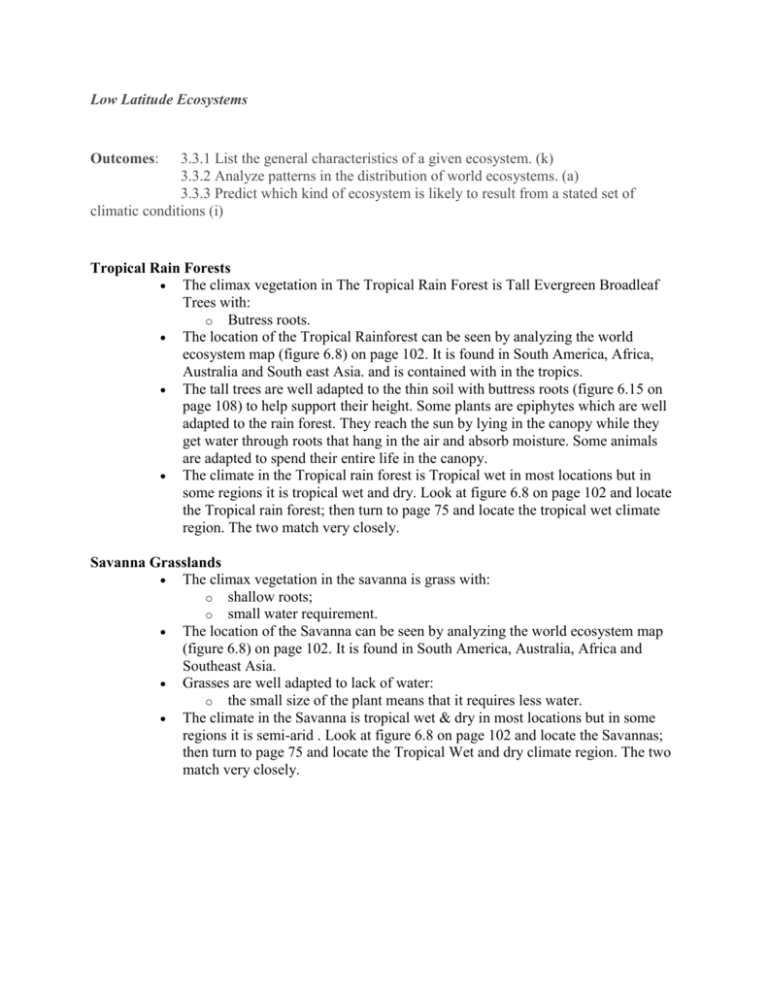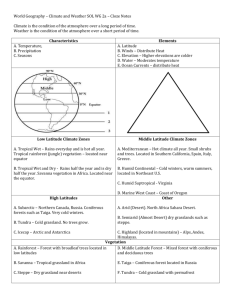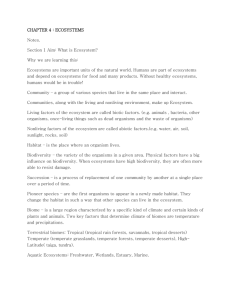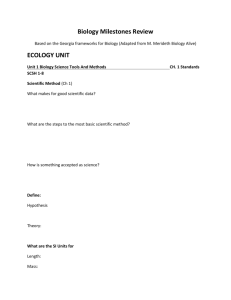5 - Low Latitude Ecosystems
advertisement

Low Latitude Ecosystems Outcomes: 3.3.1 List the general characteristics of a given ecosystem. (k) 3.3.2 Analyze patterns in the distribution of world ecosystems. (a) 3.3.3 Predict which kind of ecosystem is likely to result from a stated set of climatic conditions (i) Tropical Rain Forests The climax vegetation in The Tropical Rain Forest is Tall Evergreen Broadleaf Trees with: o Butress roots. The location of the Tropical Rainforest can be seen by analyzing the world ecosystem map (figure 6.8) on page 102. It is found in South America, Africa, Australia and South east Asia. and is contained with in the tropics. The tall trees are well adapted to the thin soil with buttress roots (figure 6.15 on page 108) to help support their height. Some plants are epiphytes which are well adapted to the rain forest. They reach the sun by lying in the canopy while they get water through roots that hang in the air and absorb moisture. Some animals are adapted to spend their entire life in the canopy. The climate in the Tropical rain forest is Tropical wet in most locations but in some regions it is tropical wet and dry. Look at figure 6.8 on page 102 and locate the Tropical rain forest; then turn to page 75 and locate the tropical wet climate region. The two match very closely. Savanna Grasslands The climax vegetation in the savanna is grass with: o shallow roots; o small water requirement. The location of the Savanna can be seen by analyzing the world ecosystem map (figure 6.8) on page 102. It is found in South America, Australia, Africa and Southeast Asia. Grasses are well adapted to lack of water: o the small size of the plant means that it requires less water. The climate in the Savanna is tropical wet & dry in most locations but in some regions it is semi-arid . Look at figure 6.8 on page 102 and locate the Savannas; then turn to page 75 and locate the Tropical Wet and dry climate region. The two match very closely. Deserts The climax vegetation in the Desert is cacti and fleshy plants with: o long roots; o water storage capability; o leaves modified as needles. The location of the Desert can be seen by analyzing the world ecosystem map (figure 6.8) on page 102. It is found in North America, South America, Australia, Africa and Asia. Deserts are mostly concentrated in two bands around the earth 10-30 North and South of the equator. Cacti are well adapted to lack of water. They are often referred to as Xerophytes: o long roots help them obtain water deep in the water table; o water storage capability gives them the ability to endure long periods without rain; o leaves modified as needles reduces the surface area for transpiration and helps reduce grazing which would severely increase water loss. Many animals have unique adaptations to the desert: o deer mice can get all the water they need from the food they eat; o toads have the behavioural adaptation of hibernating thorough the driest seasons; o some Reptiles reduce water loss by excreting solid uric acid crystals instead of water containing urine; o some mammals have the behavioural adaptation of nocturnal behaviour, which keeps them out of the day time heat. The climate in the Desert is Arid. Look at figure 6.8 on page 102 and locate the Deserts; then turn to page 75 and locate the arid climate region. The two match very closely. Mountain Ecosystems Mountains ecosystems are not exclusively low latitude, on the contrary they occur in most latitudes and as you will see in figure 6.10 on page 104 mountains can contain all types of ecosystems from all latitudes. Figure 6.10 on page 104 well-illustrates the fact that latitudinal succession closely parallels altitudinal succession. The changes we see in ecosystems as we move north from the equator are generally, tropical rain forest, Temperate forest, Coniferous forest, shrubby tundra and then polar ice cap. The same changes in ecosystem can be seen as you move up a tropical mountain. Mountain ecosystems are not very unique - they vary with altitude and temperature. Read: "Adaptation in Ecosystems" on pages 108-109.








